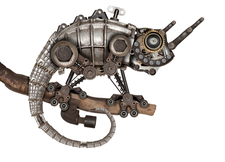Microcontroller programming with BBC micro:bit
Pocket-Size Programming

© Lead Image © Burmakin Andrey, 123rf.com
Designed for students, the BBC micro:bit, in conjunction with MicroPython and the Mu editor, can help you get started with microcontroller programming.
The idea of developing a microcontroller for schools dates back to 2012. In 2016, in cooperation with the University of Lancaster and several dozen industry partners, the British Broadcasting Corporation (BBC) delivered on this concept with the BBC micro:bit [1]. Although developed for seventh grade students, the BBC micro:bit offers an introduction to microcontroller programing for users of any age.
You can purchase the micro:bit individually for $14.95 or as the micro:bit Go Bundle (which includes batteries, a battery holder, and USB cable) for $17.50 from Adafruit [2].
The microcontroller and its components fit on a 5x4cm board (Figure 1). The 32-bit processor, an ARM Cortex-M0, runs at a clock speed of 16MHz. The micro:bit offers 16KB of RAM and a 256KB flash memory. In principle, a Bluetooth Low Energy (BLE) radio is also available. See Table 1 for more specifications.
[...]
Buy this article as PDF
(incl. VAT)
Buy Linux Magazine
Subscribe to our Linux Newsletters
Find Linux and Open Source Jobs
Subscribe to our ADMIN Newsletters
Support Our Work
Linux Magazine content is made possible with support from readers like you. Please consider contributing when you’ve found an article to be beneficial.

News
-
Linux Mint 22.3 Now Available with New Tools
Linux Mint 22.3 has been released with a pair of new tools for system admins and some pretty cool new features.
-
New Linux Malware Targets Cloud-Based Linux Installations
VoidLink, a new Linux malware, should be of real concern because of its stealth and customization.
-
Say Goodbye to Middle-Mouse Paste
Both Gnome and Firefox have proposed getting rid of a long-time favorite Linux feature.
-
Manjaro 26.0 Primary Desktop Environments Default to Wayland
If you want to stick with X.Org, you'll be limited to the desktop environments you can choose.
-
Mozilla Plans to AI-ify Firefox
With a new CEO in control, Mozilla is doubling down on a strategy of trust, all the while leaning into AI.
-
Gnome Says No to AI-Generated Extensions
If you're a developer wanting to create a new Gnome extension, you'd best set aside that AI code generator, because the extension team will have none of that.
-
Parrot OS Switches to KDE Plasma Desktop
Yet another distro is making the move to the KDE Plasma desktop.
-
TUXEDO Announces Gemini 17
TUXEDO Computers has released the fourth generation of its Gemini laptop with plenty of updates.
-
Two New Distros Adopt Enlightenment
MX Moksha and AV Linux 25 join ranks with Bodhi Linux and embrace the Enlightenment desktop.
-
Solus Linux 4.8 Removes Python 2
Solus Linux 4.8 has been released with the latest Linux kernel, updated desktops, and a key removal.

